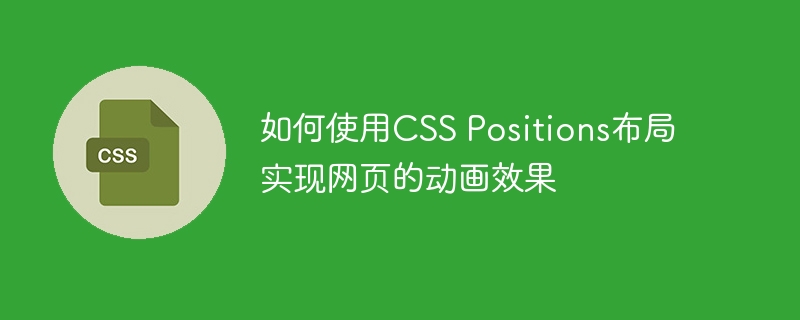

How to use CSS Positions layout to achieve animation effects on web pages
In web design, animation effects can add vividness and vitality to the page and attract the user's attention. CSS Positions is a powerful tool that can help us achieve a variety of animation effects. In this article, we will introduce in detail how to use CSS Positions layout to achieve animation effects on web pages, and provide specific code examples.
CSS Positions is a layout method of CSS that achieves web page animation effects by positioning and offsetting elements. It includes three positioning methods: static positioning, relative positioning and absolute positioning.
First, let’s introduce static positioning (static), which is the default positioning method of elements. Elements are positioned according to the document flow without any offset effect. Animation effects are not possible with static positioning, so we won't discuss them in detail in this article.
Next, we will introduce two positioning methods: relative positioning (relative) and absolute positioning (absolute), both of which can achieve animation effects.
Relative positioning (relative) allows us to achieve animation effects by specifying the offset of an element relative to its normal position. Specifically, you can use the top, right, bottom, and left properties to set the offset of an element. The following is a simple example that shows how to use relative positioning to achieve the animation effect of an element sliding in from above:
.box {
position: relative;
top: -100px;
transition: top 1s;
}
.box:hover {
top: 0;
}In the above example, we first defined a .box class and set the relative positioning and a negative offset in the vertical direction. Then, use the transition attribute to set the animation transition effect. When the mouse hovers over the element, by changing the value of top to 0, the animation effect of the element sliding in from above is achieved.
Absolute positioning (absolute) allows us to use the page as a reference point to achieve animation effects by specifying the offset of an element relative to its containing element or page. Specifically, you can use the top, right, bottom, and left properties to set the offset of an element. The following is an example that shows how to use absolute positioning to achieve the animation effect of an element sliding in from the left and fading in:
.box {
position: absolute;
left: -100px;
opacity: 0;
transition: left 1s, opacity 1s;
}
.box:hover {
left: 0;
opacity: 1;
}In the above example, we defined a .box class and set absolute positioning , negative offset in the horizontal direction and transparency. Use the transition attribute to set the animation transition effect. When the mouse hovers over the element, by changing the value of left to 0 and the value of opacity to 1, the animation effect of the element sliding in from the left and gradually appearing is achieved.
In addition, we can also combine CSS Transforms and Transitions to achieve more complex animation effects. For example, you can use the translate() function to achieve the translation effect of the element, the scale() function to achieve the scaling effect of the element, the rotate() function to achieve the rotation effect of the element, and so on.
To sum up, using CSS Positions layout can help us achieve a variety of animation effects. By using relative positioning and absolute positioning, combined with transition effects, we can easily achieve animation effects such as sliding in, fading in, panning, scaling, and rotating elements. I hope the introduction and examples in this article can help you better master the skills of CSS Positions layout to implement web page animation.
The above is the detailed content of How to use CSS Positions layout to achieve animation effects on web pages. For more information, please follow other related articles on the PHP Chinese website!




